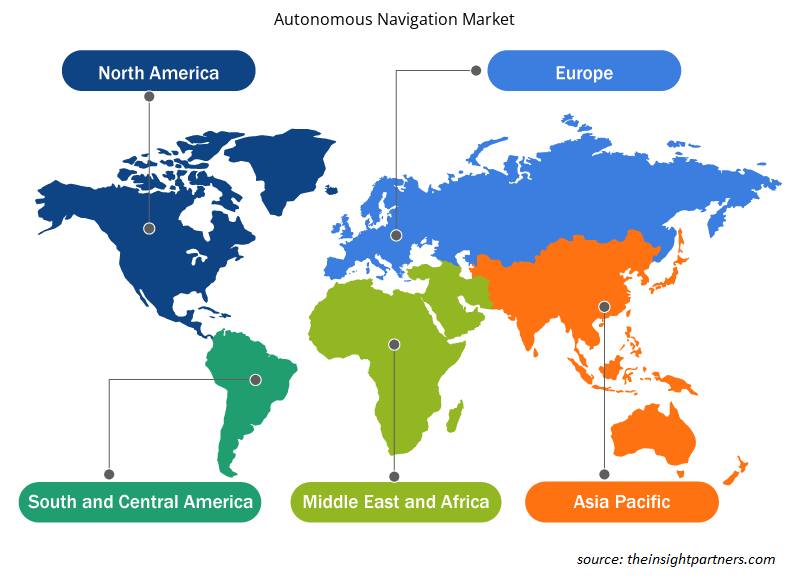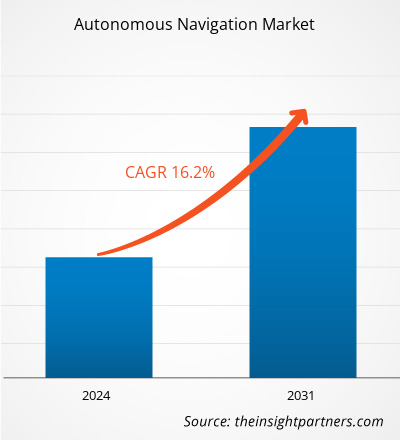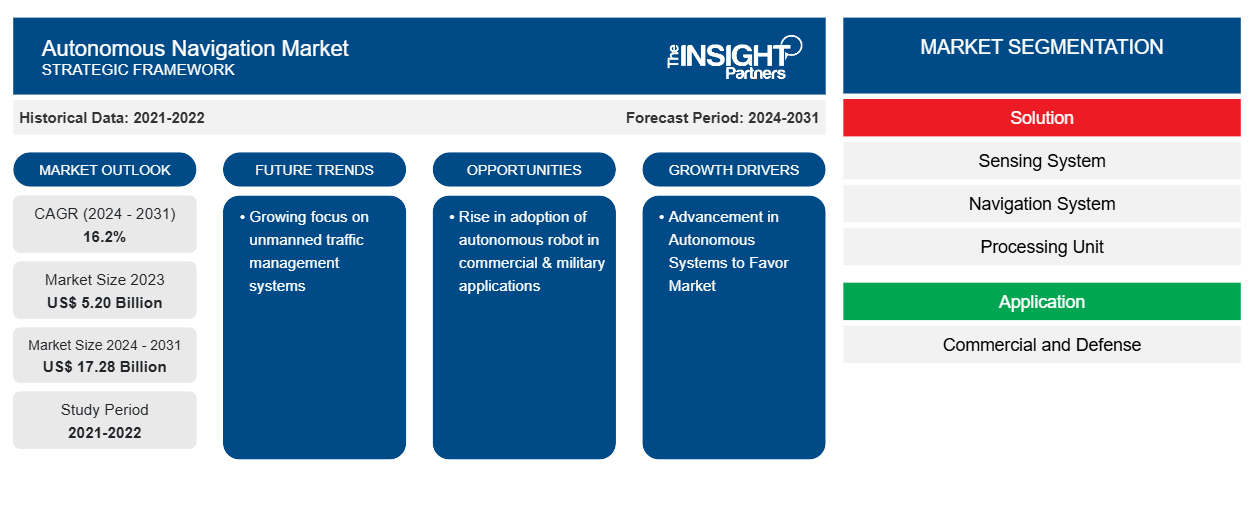Der globale Markt für autonome Navigation wird voraussichtlich von 5,20 Milliarden US-Dollar im Jahr 2023 auf 17,28 Milliarden US-Dollar im Jahr 2031 wachsen; von 2024 bis 2031 wird eine durchschnittliche jährliche Wachstumsrate von 16,2 % erwartet. Der zunehmende Fokus auf unbemannte Verkehrsmanagementsysteme wird voraussichtlich ein wichtiger Trend auf dem Markt für autonome Navigation bleiben.
Marktanalyse für autonome Navigation
Die laufenden Bemühungen, autonome Systeme weiterzuentwickeln, waren ein entscheidender Treiber im Bereich der autonomen Navigation. Die Entwicklung fortschrittlicher autonomer Navigationssysteme für eine Vielzahl von Plattformen, darunter Luft-, Land-, See- und Weltraumsysteme, hat zur Marktexpansion beigetragen.
Marktübersicht für autonome Navigation
Ein autonomes Navigationssystem ist eine komplexe Technologie, die es Fahrzeugen wie Drohnen, Robotern, Autos und Booten ermöglicht, ihre Routen ohne menschliches Eingreifen zu planen und auszuführen. Dieses System verwendet eine Kombination aus komplizierten Technologien, darunter Trägheitsnavigation, Satellitennavigation, Radar, Kameras, Ultraschall- und akustische Navigation sowie leistungsstarke Algorithmen, um intelligente Entscheidungen je nach Umgebung zu treffen. Mithilfe dieser Spitzentechnologie garantiert das autonome Navigationssystem, dass Autos präzise und sicher navigieren.
Passen Sie diesen Bericht Ihren Anforderungen an
Sie erhalten kostenlos individuelle Anpassungen an jedem Bericht, einschließlich Teilen dieses Berichts oder einer Analyse auf Länderebene, eines Excel-Datenpakets sowie tolle Angebote und Rabatte für Start-ups und Universitäten.
-
Holen Sie sich die wichtigsten Markttrends aus diesem Bericht.Dieses KOSTENLOSE Beispiel umfasst eine Datenanalyse von Markttrends bis hin zu Schätzungen und Prognosen.
Treiber und Chancen auf dem Markt für autonome Navigation
Fortschritte bei autonomen Systemen begünstigen den Markt
Technologische Verbesserungen und intensive Studien haben wesentlich zur Entwicklung autonomer Navigationssysteme beigetragen. Diese Verbesserungen haben zu einer weit verbreiteten Nutzung autonomer Fahrzeuge, Drohnen und Robotersysteme in einer Vielzahl von Branchen geführt, darunter Transport, Logistik, Landwirtschaft und Fertigung. Die zunehmenden technologischen Durchbrüche im Bereich der autonomen Navigation bieten den Herstellern autonomer Autos verschiedene Perspektiven. Die Nähe zu großen Automobilmärkten wie den Vereinigten Staaten sowie Handelsabkommen wie das Nordamerikanische Freihandelsabkommen (NAFTA) tragen zur Expansion des autonomen Navigationssektors bei.
Steigender Einsatz autonomer Roboter in kommerziellen und militärischen Anwendungen
Die Zugänglichkeit, der schnellere Service und die Zuverlässigkeit von Unternehmen auf E-Commerce-Plattformen haben die Expansion des E-Commerce -Sektors erheblich beschleunigt. Diese Expansion kann auf verschiedene Ursachen zurückgeführt werden, darunter technologische Durchbrüche und laufende Forschung und Entwicklung in den Bereichen Robotik, Computer Vision, künstliche Intelligenz und Edge Computing. Autonome Roboter spielen eine wichtige Rolle in militärischen Anwendungen. Sie werden für eine Vielzahl von Kampfunterstützungsaufgaben eingesetzt, darunter U-Boot-Abwehr, Minenlegen, Feuerunterstützung, elektronische Kriegsführung, Kampfschadensmanagement, Angriffsmissionen, Luftbetankung und mehr. Diese Roboter helfen Streitkräften auf der ganzen Welt, indem sie menschliche Späher ersetzen und Aufgaben übernehmen, die für Menschen zu riskant oder zu schwierig sind.
Segmentierungsanalyse des Marktberichts zur autonomen Navigation
Wichtige Segmente, die zur Ableitung der Marktanalyse für autonome Navigation beigetragen haben, sind Lösung, Anwendung, Fahrzeugtyp und Plattform.
- Basierend auf der Lösung ist der Markt in Sensorsystem, Navigationssystem, Verarbeitungseinheit und Software unterteilt. Das Segment Sensorsystem hatte im Jahr 2023 einen größeren Marktanteil.
- In Bezug auf die Anwendung ist der Markt in Gewerbe und Verteidigung unterteilt. Das Gewerbesegment hatte im Jahr 2023 einen größeren Marktanteil.
- Basierend auf dem Fahrzeugtyp ist der Markt in AGVs, mobile Roboter, UUVs, Drohnen und Sonstiges unterteilt. Das AGV-Segment hatte im Jahr 2023 einen größeren Marktanteil.AGVs, Mobile Robots, UUVs, Drones, and Others. The AGVs segment held a larger market share in 2023.
- Basierend auf der Plattform ist der Markt in Land, Meer und Weltraum unterteilt. Das Landsegment hatte im Jahr 2023 einen größeren Marktanteil.
Autonome Navigation Marktanteilsanalyse nach Geografie
Der geografische Umfang des Marktberichts zur autonomen Navigation ist hauptsächlich in fünf Regionen unterteilt: Nordamerika, Asien-Pazifik, Europa, Naher Osten und Afrika sowie Südamerika/Süd- und Mittelamerika. Nordamerika dominierte den Markt für autonome Navigation im Jahr 2023. Dies ist darauf zurückzuführen, dass die steigende Nachfrage nach automatisiertem Transport ein wesentlicher Treiber des Marktes für autonome Navigation in Nordamerika war. Da Industrie und Verbraucher nach effizienteren und zuverlässigeren Transportlösungen suchen, ist die Nachfrage nach autonomen Navigationssystemen gestiegen.
Regionale Einblicke in den Markt für autonome Navigation
Die regionalen Trends und Faktoren, die den Markt für autonome Navigation im Prognosezeitraum beeinflussen, wurden von den Analysten von Insight Partners ausführlich erläutert. In diesem Abschnitt werden auch die Marktsegmente und die Geografie für autonome Navigation in Nordamerika, Europa, im asiatisch-pazifischen Raum, im Nahen Osten und Afrika sowie in Süd- und Mittelamerika erörtert.

- Holen Sie sich regionale Daten zum Markt für autonome Navigation
Umfang des Marktberichts zur autonomen Navigation
| Berichtsattribut | Details |
|---|---|
| Marktgröße im Jahr 2023 | 5,20 Milliarden US-Dollar |
| Marktgröße bis 2031 | 17,28 Milliarden US-Dollar |
| Globale CAGR (2024 - 2031) | 16,2 % |
| Historische Daten | 2021-2022 |
| Prognosezeitraum | 2024–2031 |
| Abgedeckte Segmente |
Nach Lösung
|
| Abgedeckte Regionen und Länder |
Nordamerika
|
| Marktführer und wichtige Unternehmensprofile |
|
Dichte der Marktteilnehmer für autonome Navigation: Die Auswirkungen auf die Geschäftsdynamik verstehen
Der Markt für autonome Navigation wächst rasant, angetrieben durch die steigende Nachfrage der Endnutzer aufgrund von Faktoren wie sich entwickelnden Verbraucherpräferenzen, technologischen Fortschritten und einem größeren Bewusstsein für die Vorteile des Produkts. Mit steigender Nachfrage erweitern Unternehmen ihr Angebot, entwickeln Innovationen, um die Bedürfnisse der Verbraucher zu erfüllen, und nutzen neue Trends, was das Marktwachstum weiter ankurbelt.
Die Marktteilnehmerdichte bezieht sich auf die Verteilung der Firmen oder Unternehmen, die in einem bestimmten Markt oder einer bestimmten Branche tätig sind. Sie gibt an, wie viele Wettbewerber (Marktteilnehmer) in einem bestimmten Marktraum im Verhältnis zu seiner Größe oder seinem gesamten Marktwert präsent sind.
Die wichtigsten auf dem Markt für autonome Navigation tätigen Unternehmen sind:
- BlueBotics SA
- YUJIN ROBOT Co., Ltd.
- KONGSBERG
- Trimble Inc.
- ASI Roboter
- Collins Luft- und Raumfahrt
Haftungsausschluss : Die oben aufgeführten Unternehmen sind nicht in einer bestimmten Reihenfolge aufgeführt.

- Überblick über die wichtigsten Akteure auf dem Markt für autonome Navigation
Neuigkeiten und aktuelle Entwicklungen zum Markt für autonome Navigation
Der Markt für autonome Navigation wird durch die Erhebung qualitativer und quantitativer Daten nach Primär- und Sekundärforschung bewertet, die wichtige Unternehmensveröffentlichungen, Verbandsdaten und Datenbanken umfasst. Im Folgenden finden Sie eine Liste der Entwicklungen auf dem Markt:
- Im Juni 2022 startete BlueBotics ANTdriven.com, eine neue Bildungsressource, die Fachleuten beim Einstieg in den AGV-Bereich (Automated Guided Vehicle) helfen soll. Die Plattform bietet klare und hilfreiche Bildungsinhalte und nützliche Tools und bietet sogar kostenlose Expertenberatung. Sie soll potenziellen Käufern dabei helfen, Herausforderungen zu meistern und die am besten geeigneten automatisierten Fahrzeuge für ihr Unternehmen zu finden. ANTdriven.com bietet eine breite Palette an Inhalten für jeden Besucher, unabhängig davon, wo er sich auf seiner AGV-Reise befindet.
(Quelle: BlueBotics, Pressemitteilung, 2022)
Marktbericht zur autonomen Navigation – Abdeckung und Ergebnisse
Der Bericht „Marktgröße und Prognose für autonome Navigation (2021–2031)“ bietet eine detaillierte Analyse des Marktes, die die folgenden Bereiche abdeckt:
- Marktgröße und Prognose auf globaler, regionaler und Länderebene für alle wichtigen Marktsegmente, die im Rahmen des Projekts abgedeckt sind
- Marktdynamik wie Treiber, Beschränkungen und wichtige Chancen
- Wichtige Zukunftstrends
- Detaillierte PEST/Porters Five Forces- und SWOT-Analyse
- Globale und regionale Marktanalyse mit wichtigen Markttrends, wichtigen Akteuren, Vorschriften und aktuellen Marktentwicklungen
- Branchenlandschaft und Wettbewerbsanalyse, einschließlich Marktkonzentration, Heatmap-Analyse, prominenten Akteuren und aktuellen Entwicklungen
- Detaillierte Firmenprofile
- Historische Analyse (2 Jahre), Basisjahr, Prognose (7 Jahre) mit CAGR
- PEST- und SWOT-Analyse
- Marktgröße Wert/Volumen – Global, Regional, Land
- Branchen- und Wettbewerbslandschaft
- Excel-Datensatz
Aktuelle Berichte
Erfahrungsberichte
Grund zum Kauf
- Fundierte Entscheidungsfindung
- Marktdynamik verstehen
- Wettbewerbsanalyse
- Kundeneinblicke
- Marktprognosen
- Risikominimierung
- Strategische Planung
- Investitionsbegründung
- Identifizierung neuer Märkte
- Verbesserung von Marketingstrategien
- Steigerung der Betriebseffizienz
- Anpassung an regulatorische Trends























 Kostenlose Probe anfordern für - Markt für autonome Navigation
Kostenlose Probe anfordern für - Markt für autonome Navigation